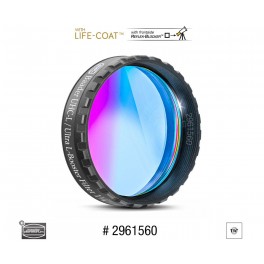 Ingrandisci
Ingrandisci Filtro UHC-L Ultra-L-Booster 31,8mm
Baader Planetarium
- Rimuovi questo prodotto dai miei preferiti
- Aggiungi questo prodotto ai miei preferiti.
- Stampa
Baader 1.25" UHC-L Ultra-L-Booster Nebula Filter for Astrophotography
 Ingrandisci
Ingrandisci Baader 1.25" UHC-L Ultra-L-Booster Nebula Filter for Astrophotography
Codice articolo: BP2961560
![Baader 1.25" UHC-L Ultra-L-Booster Nebula Filter for Astrophotography [EN] Baader 1.25" UHC-L Ultra-L-Booster Nebula Filter for Astrophotography [EN]](https://www.teleskop-express.it/img/cms/baader-2961560-a-uhc-l-ultra-l-booster-filter-1.25-zoll.jpg)
♦ Ultra-high contrast L Filter, blocks city lights and increases contrast of nebulae and comets (C2 lines)
♦ Can be used as an LED-optimized luminance filter for LRGB imaging with skyglow suppression
♦ Creates a much brighter image than classical nebula filters
♦ Blue transmission optimized to block blueish skyglow caused by LED car and street lights.
♦ Ideal for deep sky observers. This UHC-L filter is the perfect visual complement to narrowband OIII filters.
♦ Reflex-Blocker hard-coated and plane-optical polished - with sealed coating edges (Life-Coat)
♦ Blackened edges all around, with filter-lead-side indicator in the form of a telescope-side black outer rim
![Baader 1.25" UHC-L Ultra-L-Booster Nebula Filter for Astrophotography [EN] Baader 1.25" UHC-L Ultra-L-Booster Nebula Filter for Astrophotography [EN]](https://www.teleskop-express.it/img/cms/baader-296156-uhc-l-ultra-l-booster-filter-transmission.jpg)
The Baader UHC-L filter is the classic allround "light pollution rejection filter", but now also blocked against the main LED emissions in the blue part of the spectrum. The passband curve corresponds to a wide dual-band filter without distorting star colors. The two passbands transmitt all light emitted by the known gas nebulae (the H-alpha and H-beta lines of fluorescent hydrogen as well as the [O III] line of oxygen), while both the atmospheric most disturbing stray light from LED lamps and intense bluish car headlights as well as further stray light from classical street lamps and the natural night sky glow (airglow/skyglow) of the atmosphere are blocked to a large extent. The UHC-L filter blocks false light much more effective than all previous UHC filters.
Use of the UHC-L filter
The application of the UHC-L happens mainly in visual and photographic observation of emission nebulae (star forming regions, planetary nebulae, supernova remnants) under medium to highly polluted skies. Its use is also interesting for comet observation: It passes the OIII line at 501 nm as well as the two C2 lines at 511 nm and 514 nm which are characteristic for the gas tail of many comets.
This UHC-L filter is the successor of the well-proven plane-optical polished Baader UHC-S filter. It consequently complements it with the advantages of CMOS optimization (no disturbing halos, blackened filter edges, Life-Coat-coating) while providing an improved transmission spectrum adapted to also cover modern LED light pollution. It provides a brighter image than many classic LPR (Light Pollution Rejection) filters and is therefore not only suitable for large, fast instruments, but also for smaller telescopes collecting less light, where a large exit pupil cannot be achieved. This applies for long-focal length telescopes as well as for small aperture telescopes that only have an eyepiece socket for 1.25" eyepieces. Unlike the single line or dual-line narrowband filters, the image is also bright enough for high magnification, while not diminishing the number of stars. For deep-sky observers, therefore, this UHC-L filter is the perfect visual complement to narrowband [O III] filters.
The UHC-L filter is also excellent for photographic use. It does not just block polluting terrestrial light sources, but at the same time it serves as a luminance filter (L-filter), since it blocks all UV and IR transmission like a UV/IR cut filter. An additional UV/IR-cut filter is therefore not necessary: Cameras without a built-in UV/IR-cut filter thus deliver significantly sharper images on refracting telescopes. Both classical photographers and users of EAA/LiveStacking do benefit from the increased sharpness of stars and better contrast of nebulae, as well as the improved transmittance in H-alpha.
Like all Baader CMOS-optimized filters, Baader UHC-L filters likewise are plano-optically polished, with ultra-hard, sputtered dielectric coatings. Even a one-hour bath in boiling water cannot harm these filters! They are scratch-resistant and can be cleaned as often as desired.
